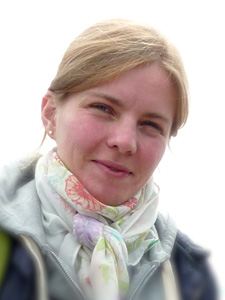Dr Paulina Janik
Assistant Professor

Research interests
- Taxonomy, biogeography and ecology of nivicolous myxomycetes.
- Intra- and interspecific morphological and genetical variability of myxomycetes, particularly nivicolous myxomycetes.
Higher education and employment history
- MSc degree at the Jagiellonian University (2008).
- Research Assistant at the W. Szafer Institute of Botany, PAS.
Membership and awards
- Member of International Society of Protistologists (since 2020)
International experience
- Germany (2014) - research training at Institut für Botanik und Landschaftsökologie, Ernst-Moritz-Arndt-Universität Greifswald
- China (2014) - research stay, revision of herbarium collections of nivicolous myxomycetes, Fungarium of Chinese Academy of Sciences (HMAS), Institute of Microbiology
- Spain (2015) - research stay at Real Jardín Botánico, Consejo Superior de Investigaciones Científicas (CSIC)
- Spain (2016) - scholarship UE SYNTHESYS (ES-TAF-5973) at Real Jardín Botánico, Consejo Superior de Investigaciones Científicas (CSIC)
Research projects
- Preliminary assessment of morphological and genetical traits in the context of comprehensive variability analysis of a nivicolous myxomycete Didymium nivicolum Meyl. in its whole distribution range (2014); grant no. 10/2014, grant "Young Scientists"; W. Szafer Institute of Botany, PAS – project leader.
- Analysis of intra- and interspecific variability of nivicolous myxomycetes in the context of resolving complex taxonomic problems (2015); grant no. 6/2015, grant "Young Scientists"; W. Szafer Institute of Botany, PAS – project leader.
- Analysis of morphological variability and distribution of Andean populations of Didymium nivicolum Meyl. (Myxomycetes) (2016); grant no. 1/2016, grant "Young Scientists"; W. Szafer Institute of Botany, PAS – project leader.
- Analysis of genetical variability of an endemic nivicolous myxomycete Physarum andinum A.Ronikier & Lado (Myxomycetes) (2017); grant no. 1/2017, grant "Young Scientists"; W. Szafer Institute of Botany, PAS – project leader.
- Testing DNA isolation methods from small amounts of herbarium material: is it possible to overcome a major limitation in genetical analyses of myxomycetes? (2018); grant no. 4/2018, grant "Young Scientists"; W. Szafer Institute of Botany, PAS – project leader.
- Mixobiota tropical. VI. Estudio biosistemático de Amoebozoa (Myxomycetes y Arcellinida) de los salares andinos (Neotropical Myxobiota. VI. A biosystematic study of the Amoebozoa (Myxomycetes and Arcellinidae) from the Andean salt flats) (2019-2021); grant no. PGC2018-094660-B-I00 (MCIU/AEI/FEDER, UE), Ministry of Science, Innovation and Universities, Government of Spain – co-investigator.
Recent publications (selected)
Czachura P., Janik P. 2025. Resin outpourings on conifers are inhabited by more members of Nectriaceae (Hypocreales, Sordariomycetes) than previously thought. MycoKeys 113: 337–358. DOI
Czachura P., Janik P. 2024. Lophium arboricola (Mytilinidiales, Ascomycota) from conifer resins. Plant and Fungal Systematics 69: 1–6. DOI
Hyde K.D., Noorabadi M.T., Thiyagaraja V., He M.Q., Johnston P.R., Wijesinghe S.N., Armand A., Biketova A.Y., Chethana K.W.T., Erdoğdu M., et al. 2024. The 2024 Outline of Fungi and fungus-like taxa. Mycosphere 15: 5146–6239. DOI
Hyde K.D., Abdel-Wahab M.A., Abdollahzadeh J., Abeywickrama P.D., Absalan S., Afshari N., Ainsworth A.M., Akulov O.Y., Aleoshin V.V., Al-Sadi A.M., et al. 2023. Global consortium for the classification of fungi and fungus-like taxa. Mycosphere 14: 1960–2012. DOI
Janik P., Malicki M., Ronikier A., Suchan T. 2023. Nowe stanowisko Clathrus archeri (Phallaceae, Agaricomycetes) w Karkonoskim Parku Narodowym. Fragmenta Floristica et Geobotanica Polonica 28: 188–191. DOI
Paul W., Janik P., Ronikier A. 2023. Checklist of Myxomycetes (Amoebozoa) of the Polish Tatra Mts. Acta Mycologica 58: 178396. DOI
Janik P., Shchepin O., Moreno G., Ronikier A. 2022. Contribution to the island biogeography – case study of a nivicolous myxomycete Didymium nivicola (Myxomycetes) from Tenerife. Nova Hedwigia 115: 143–155. DOI
Ronikier A., Janik P., de Haan M., Kuhnt A., Zankowicz M. 2022. Importance of type specimen study for understanding genus boundaries – taxonomical clarifications in Lepidoderma based on integrative taxonomy approach leading to resurrection of the old genus Polyschismium. Mycologia 114: 1008–1031. DOI
Janik P., Szczepaniak M., Lado C., Ronikier A. 2021. Didymium pseudonivicola: A new myxomycete from the austral Andes emerges from broad-scale morphological and molecular analyses of D. nivicola collections. Mycologia 113: 1327–1342. DOI
Janik P., Lado C., Ronikier A. 2020. Range-wide phylogeography of a nivicolous protist Didymium nivcola Meyl. (Myxomycetes, Amoebozoa): Striking contrasts between the Northern and the Southern Hemisphere. Protist 171: 125771. DOI
Janik P., Ronikier M., Ronikier A. 2020. New protocol for successful isolation and amplification of DNA from exiguous fractions of specimens: a tool to overcome the basic obstacle in molecular analyses of myxomycetes. PeerJ 8: e8406. DOI
Feng Y., Klahr A., Janik P., Ronikier A., Hoppe T., Novozhilov Y.K., Schnittler M. 2016. What an intron may tell: several sexual biospecies coexist in Meriderma spp. (Myxomycetes). Protist 167: 234–253. DOI
Janik P., Ronikier A. 2016. Meriderma species (Myxomycetes) from the Polish Carpathians: a taxonomic revision using SEM-visualized spore ornamentation. Acta Societatis Botanicorum Poloniae 85: 3492. DOI
Wojtczak G., Janik P. 2016. Phytoremediation with Geosiphon-like symbiosis? Environmental Science and Pollution Research 23: 5992–5994. DOI





